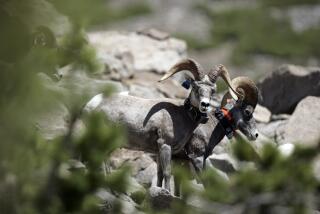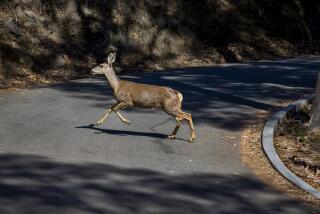Animals Teach a Valuable Lesson About Human Nature
AMERICAN BISON
A Natural History
By Dale F. Lott
University of California Press
220 pages, $29.95
Many animals have two identities. There’s the real creature that lives on this planet, and there’s the imaginary creature that lives in our minds.
So contends Dale F. Lott, behavioral ecologist and professor emeritus at the UC Davis, in “American Bison,” a natural history of the majestic animals that were once hallmarks of the vast American grasslands.
“The real animal,” he writes quite eloquently, “is a product of natural selection; the mythical one is a product of our yearnings and fears. The real one can teach us about nature; the mythical one can teach us about human nature.”
In this rich and enthusiastic narrative, Lott uses exuberant humor and great passion for his subject to elicit reader interest, illuminating the biological and mythical bison--popularly known as the buffalo--and what they tell us about nature, human and otherwise.
Storytelling--not lecturing--is a practice he has honed over 35 years of teaching, and it is the scenes he sketches that bring his story to life.
Readers enter intense episodes of bison interaction and fierce mating behavior, witness displays of the animal’s imposing physical deftness and observe complex social communication, with Lott interpreting for us each nuance.
Lott’s fascination with bison did not begin from a vague point of scientific curiosity or with the altruistic desire to save the vanishing species.
Born on the National Bison Range in Western Montana, Lott was the grandson of the range superintendent, his father a range employee; bison are a lens through which he views the world.
“I first encountered bison not as symbols of the West, the squandering of a natural resource, or a conservation triumph,” he writes. “They were simply the animals I had seen most often when I was a young child--enthralling in and of themselves.”
In sketching a portrait of the bison’s precarious place in America today, Lott bemoans the compromised state of the prairies, a once rich and vibrant ecosystem that no longer exists in its grandeur.
But Lott acquaints readers with more than just the fragile ecological balance of these grasslands and their iconic hulking inhabitants. He brings us into the actual neighborhood.
As we encounter the animal community--wolves, prairie dogs, badgers, ferrets, buffalo birds, pronghorn and grizzly bears--that populate the bison’s home turf, we come to feel the sun overhead and the wind whistling through the grass.
As poetic as he is, Lott also has a light touch.
Describing grizzly bear habits, for example: “Given the choice, a papa bear is much more likely to eat a baby bear than a bowl of porridge,” we’re told.
And the black-footed ferret, the badger’s slender cousin, Lott depicts as a recluse, haunting prairie dogs’ imaginations.
“You can recognize this nightmare as soon as you see its face. The black-footed ferret’s face mask reveals itself as surely as the Lone Ranger’s mask hid his.”
At the heart of his story, however, is a call for conserving the concept of wildness: both the wildness of the land on which the bison live and that of the untamed nature of the animal.
Even if we should begin to domesticate bison as livestock--they are, after all, “preadapted to our continent and easy on the soil” with flesh that “is not as fatty as European cattle’s and is said to be less allergy-provoking,” and thus a potential substitute for the cattle whose grazing has helped decimate the grasslands--he warns that we shouldn’t confuse these domesticated “buffattle” with wild bison, “the only wild animal in the United States that is not allowed to live as a wild animal ... anywhere in its original range.”
To this end, he calls for the creation of a Great Plains Park where bison can, without encumbrance, live their raucous lives, where the real and mythical bison might continue to thrive.
Even if it’s too late to preserve the Great Plains as they once existed, it’s not too late, Lott argues, to restore a portion of those plains, and the bison’s place upon them.
More to Read
Sign up for Essential California
The most important California stories and recommendations in your inbox every morning.
You may occasionally receive promotional content from the Los Angeles Times.










